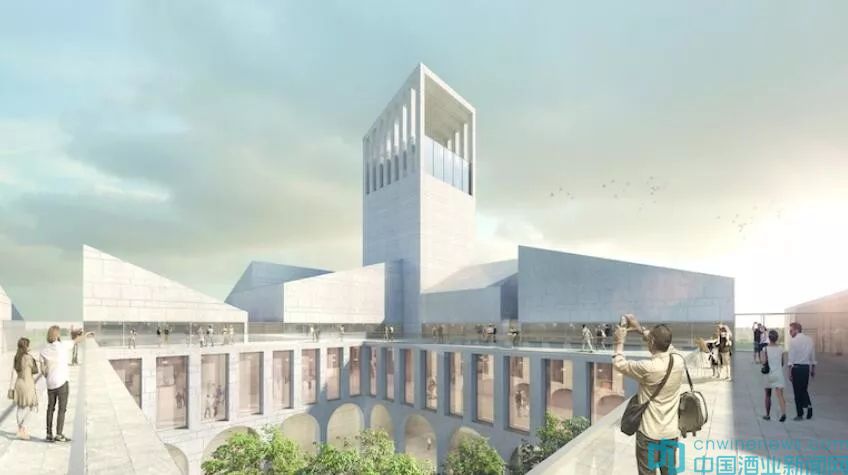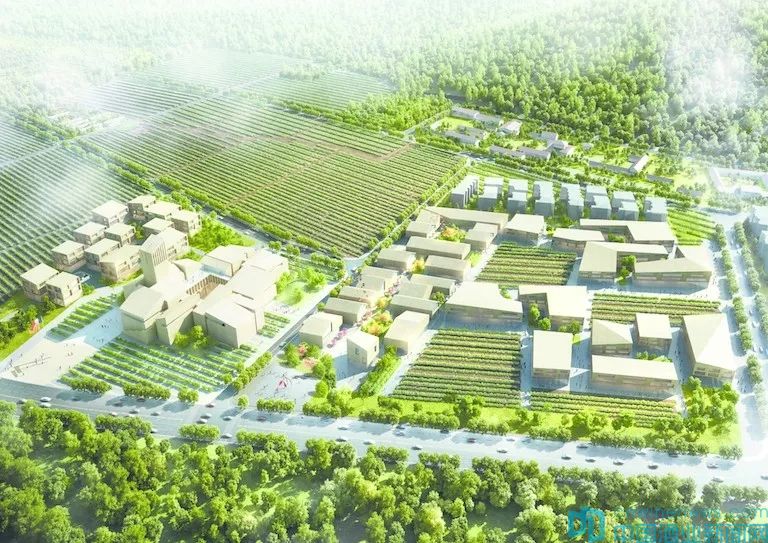Clustered buildings, cubist lines, structures in stone — the iconic medieval village of Saint-Emilion, which is a UNESCO world heritage site, has provided the main source of inspiration for the future Universal Wine Museum in Beijing. Launched in partnership with the Cité du Vin wine museum in Bordeaux, France, the project aims to become the main centre in China and Asia for all things relating to wine.

Beijing’s vast Universal Wine Museum will be ranged around a tower inspired by church architecture. (Photo: AFP/ ArchitectureStudio_1)
Located in Zhong Pu Hui Wine Village 40 kilometres from the Forbidden City, an 18,000-square-metre site has been reserved for the future pedagogical resource, which will offer a comprehensive introduction to oenology and wine culture.
Drawing extensively on the architecture of Saint-Emilion, the new complex — which will be set in a sea of vines — will feature a tower and a cloister. Visitors to the future tourist attraction will be invited on a tour covering 6,700sqm that will elucidate all the aspects of winemaking, as well as the long history of a drink that is for many Western civilisations a key aspect of the art of living.
Like the Cité du Vin in Bordeaux, the new facility will offer multi-sensory exhibits to educate visitors on all aspects of wine tasting, including the balance of acidity and sweetness and the expression of tannins. It will also be home to a school, where students can embark on courses to develop their understanding of how to pair and serve wine, a cellar and a gourmet restaurant.

A bird’s eye view of Beijing’s Universal Wine Museum. (Photo: Architecte Studio)
“The concept of the museum is the same as the Cité du Vin, but its DNA has taken a different form,” points out Philippe Massol, the managing director of Fondation de la culture et des civilisations du vin. “The tour will follow an established route, because many Chinese visitors will benefit from a more guided approach, as opposed to the Cité du Vin in Bordeaux, where visitors come and go as they please.”
Another important difference will be the absence of interactive pedagogical installations. “Chinese tourists favour more concrete exhibits,” explains Massol.
The Beijing Universal Wine Museum aims to welcome half a million visitors in its first year. Building work is set to begin next April. It will be the first step in a plan that has been developed over the last two years, points out the museum’s president and founder, Weixang Tang, at a presentation of the project.
The museum will be just one destination in a wine village extending over eight square kilometres, where travellers will have the opportunity to spend several days exploring the world of Bacchus. There are plans for a luxury hotel to be built at the foot of Mount Wulan, while more budget-conscious visitors can opt for a second, more affordable establishment.
Visiting families can reserve weekend cottages at the village’s educational farm and riding stables. Last but not least, there will be a mall with stores and restaurants, which will once again be inspired by French urban architecture.
Although China is more traditionally oriented towards beer and strong liquor like maotai, wine is increasingly popular in the Middle Kingdom. According to the 2018 Vinexpo study, the Chinese market accounts for 1.46 billion litres of wine per year, which makes it the world’s fifth largest. It is also worth noting that the current level of consumption is expected to rise by 18.5% by 2021, just in time for the opening of Beijing’s new Universal Museum of Wine.
北京葡萄酒博物馆2021年面世
到2021年,一座以波尔多“葡萄酒之城(La Cité du Vin)”为模型的葡萄酒博物馆将在北京房山中葡汇葡萄酒小镇建成。该项目与法国波尔多Cité du Vin葡萄酒博物馆共同发起,投资达6650万美元,旨在打造成中国和亚洲的葡萄酒文化中心。
成群的建筑物,立体派的线条,石质的结构——作为联合国教科文组织世界遗产的中世纪圣埃美隆小镇,为未来的北京葡萄酒博物馆提供了主要的灵感来源。距故宫约40公里的中葡汇葡萄酒小镇,预留了18,000平方米的场地用于未来的葡萄酒文化展示和教育。
新建筑群将广泛采用圣埃美隆的建筑风格,坐落于一片葡萄树中,并设有塔楼和回廊。游客将可在占地6,700平方米的空间里展开一场葡萄酒之旅,体验与葡萄酒酿造有关的所有方面,了解葡萄酒这一在许多西方文明中作为生活艺术重要组成部分的饮品的悠久历史。
像波尔多的Cité du Vin一样,新博物馆也将提供多感官展示,让游客体验葡萄酒的各个方面,包括酸度和甜度的平衡以及单宁的表达。它还将是一所葡萄酒学校,学生们可以通过参加课程来加深对餐酒搭配、侍酒知识的了解,此外,它还将兼具酒窖和美食餐厅的功能。
“北京葡萄酒博物馆的概念与波尔多葡萄酒博物馆相同,但其DNA却呈现不同的形式,” 管理La Cité du Vin的葡萄酒文化与文明基金会总经理Philippe Massol说。“这一葡萄酒之旅将遵循既定路线,因为许多中国游客更倾向于引导性参观,而在波尔多葡萄酒博物馆,游客可以随意游览。”
另一个重要的区别是没有互动式的教学装置。“中国游客偏爱更具体的展览品。” Massol解释道。
波龙堡集团董事长唐卫星是北京葡萄酒博物馆建设的负责人。该博物馆的目标是在第一年吸引50万游客。
尽管中国在传统上更倾向于啤酒和烈性酒,但葡萄酒近年来在中国越来越受欢迎。根据2018年Vinexpo的研究,中国市场每年的葡萄酒消费量为14.6亿升,为世界第五大葡萄酒消费国。值得注意的是,到2021年北京葡萄酒博物馆建成时,中国的葡萄酒消费水平预计将增长18.5%,从而成为仅次于美国的全球第二大葡萄酒市场。
来自:法新社
编译:华夏酒报记者徐菲远

